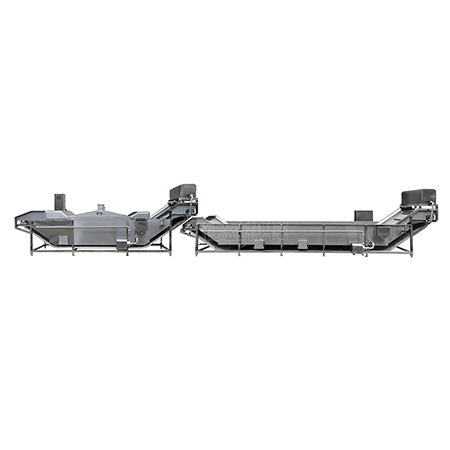
Vegetable Blanching Machine is mainly used for short-term heat treatment of vegetables to kill enzymes, soften and maintain the color, taste and nutrition of vegetables.
This equipment is widely used in the food processing industry, especially in the production of quick-frozen vegetables, canned vegetables and dehydrated vegetables. Through precise temperature and time control, it effectively extends the shelf life of vegetables and prepares for subsequent processing links.
A vegetable blancher is a specialized food processing equipment designed for blanching vegetables. Blanching is a cooking process where vegetables are briefly exposed to high-temperature water or steam and then rapidly cooled down. This method is employed to kill bacteria, enzymes, and molds on the surface of vegetables, while preserving their color, texture, and nutritional content, ultimately extending their shelf life.
The vegetable blancher typically consists of several key components:
Heating Tank: This tank contains hot water or steam where vegetables are exposed to high temperatures to eliminate microorganisms and enzymes.
Conveyor System: A conveyor belt or other conveying mechanisms transport the vegetables into the heating tank and then move them into the cooling tank.
Cooling Tank: In this tank, vegetables are rapidly cooled using cold water or cooling air, stopping the cooking process.
Control System: The blancher is equipped with a control system to monitor and regulate the temperature of the heating and cooling tanks, ensuring precision and consistency in the blanching process.
Drainage System: There is a drainage system to remove the water from the heating and cooling tanks, as well as handle wastewater generated during the processing.
Features: The blanching section completely immerses the materials in water to make the materials blanched evenly; the conveyor belts are all designed with scrapers, so that the blanching time of the materials in the water is basically the same; the entire line has continuity, uniform temperature, and automatic temperature control ; Stepless speed regulation; small steam consumption, hot water circulation, soda and water mixing; mainly made of 304 stainless steel, strong and long service life.
Conclusion
Vegetable blanchers play a crucial role in the food processing industry as they help maintain the quality of vegetables, prolong their shelf life, and ensure food safety. These machines come in various configurations, catering to different processing capacities, heating methods, and levels of automation, allowing food processing facilities to choose the most suitable option based on their specific requirements.
FAQ
What Types of Vegetables Are Commonly Blanched?
Various vegetables are blanched, including broccoli, carrots, peas, green beans, and potatoes. Blanching helps maintain their quality and extends their shelf life by eliminating surface bacteria and enzymes.
Why Is Blanching Important in Food Processing?
Blanching is crucial in food processing because it deactivates enzymes that can cause undesirable changes in color, flavor, and texture. It also helps kill bacteria and molds, ensuring the safety and quality of processed vegetables.
Are Blanched Vegetables Healthier Than Raw Vegetables?
Blanching helps retain the nutritional value of vegetables by preserving essential vitamins and minerals. While some nutrients may be lost during blanching, it is generally considered a healthier option than overcooking or consuming raw vegetables contaminated with harmful microorganisms.
How Long Do Vegetables Need to Be Blanched?
The blanching time varies based on the type and size of vegetables. Generally, smaller vegetables require shorter blanching times (around 1-2 minutes), while larger or denser vegetables may need 3-5 minutes of blanching.
Can Blanched Vegetables Be Used in Salads?
Yes, blanched vegetables can be used in salads. Blanching helps enhance the color and texture of vegetables, making them a great addition to salads while ensuring they are safe to eat.
Is Blanching the Same as Boiling Vegetables?
Blanching and boiling are similar processes involving hot water, but blanching is a shorter, quick-cooking method used to partially cook vegetables. Boiling usually involves cooking vegetables thoroughly until tender.
Can Blanching Affect the Taste of Vegetables?
Properly blanched vegetables retain their natural taste and may even enhance their flavor. Overblanching or underblanching, however, can negatively impact the taste and texture of the vegetables.
What Is the Ideal Blanching Temperature?
The ideal blanching temperature is typically around 190°F (88°C) for most vegetables. However, specific temperatures may vary depending on the type of vegetable being processed.
Are Blanching Machines Used in Large-Scale Food Processing Plants?
Yes, blanching machines are extensively used in large-scale food processing plants to efficiently and uniformly blanch vegetables. These machines streamline the blanching process, ensuring consistency and quality in the final products.
What Precautions Should Be Taken During the Blanching Process?
During blanching, it is essential to monitor the temperature and blanching time carefully. Overblanching can lead to loss of nutrients and texture, while underblanching may not effectively deactivate enzymes and bacteria. Proper cooling after blanching is also crucial to stop the cooking process promptly.
| Technical Parameters | |
| Overall dimensions | 11000×1200×1500mm (5 meters for blanching, 6 meters for cooling) |
| Voltage | 380V |
| Power | 6.75kW |